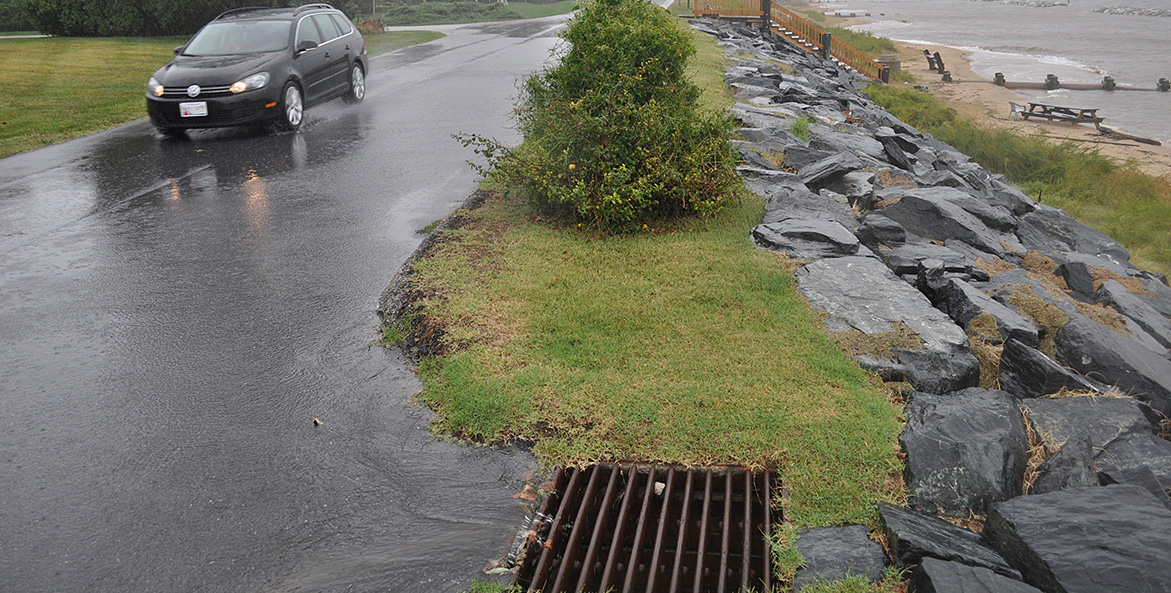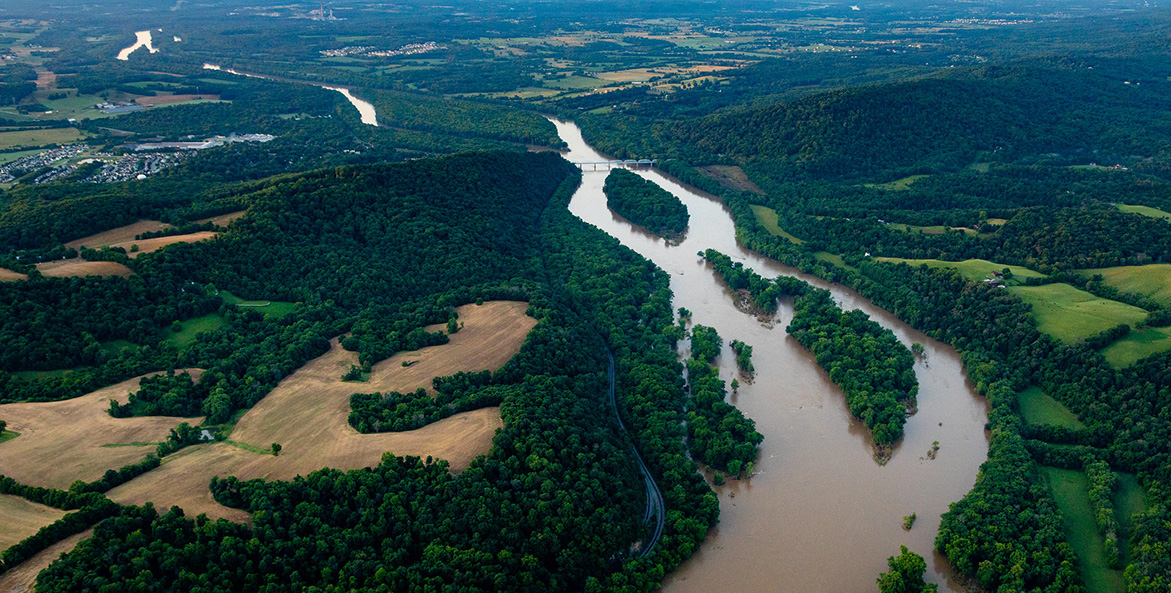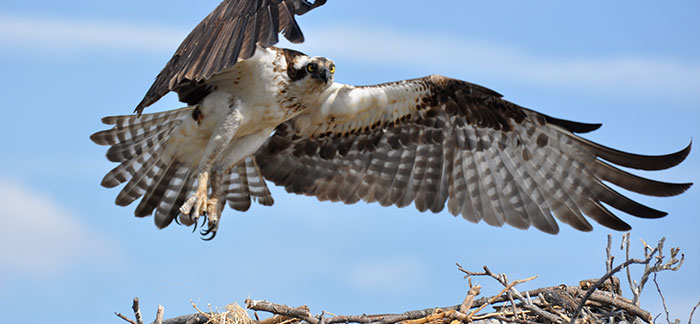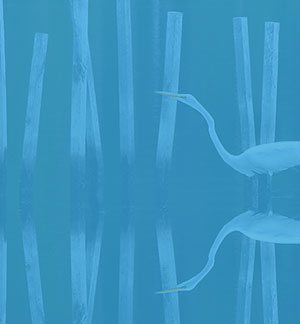Like many others in Maryland, we’ve been enjoying what feels like clear blue skies and lush green trees each day this spring. In these pleasant conditions, it can be easy to overlook the fact that the majority of Maryland is actually in an extreme drought—nearly all of the state has been at least abnormally dry since fall of 2024, according to weather forecasting by University of Maryland Extension.
We often talk about water quality as a key concern in the Bay. However, water quantity is becoming an equally important issue.
Climate change is causing less frequent, but more intense rainstorms throughout the Bay region. Despite experiencing more flooding than ever before, on average we’re getting much less precipitation than our native ecosystems are used to.
In years when we get less rainfall, we actually may see better water quality and a smaller dead zone in the Bay’s deep channel. For example, the dead zone was the smallest on record in 2023, and about average in 2024. However, there are several reasons drought conditions can be harmful to habitats, local food production, and the health of the Chesapeake Bay.
“While the shrinking dead zone is a positive sign, it’s not the whole story of Bay health,” said CBF Staff Scientist Gussie Maguire. She said the Bay’s many tributaries will still experience elevated levels of contamination during drought conditions and can even dry up entirely.
“This impacts water supply depletes habitat for fish, and puts stress on our native species, who may struggle to adapt to the rapidly changing regional climate,” Maguire said.
Drier Soil
One of the biggest concerns is our soil’s ability to retain water. Healthy soil has amazing water retention capacity, and the more organic matter the soil has, the more water it can absorb. For every 1 percent increase in soil’s organic matter, it can hold an additional 25,000 gallons of water per acre, according to the U.S. Department of Agriculture.
The more we can make our soil like a sponge, the more we can take advantage of what little rainfall we’re getting.
Prolonged droughts can dry out the soil and make it less absorbent. Not only is that challenging for farmers who are growing our food, but it also makes the soil more prone to flooding. When the next sudden rainfall hits, less water will be retained by the soil and it will end up running right off the ground into our local waterways—often taking whatever nitrogen, phosphorus or sediment pollution is on the surface with it. This is known as stormwater pollution.
Saltier Water
Droughts can also be a concern for drinking water. Last summer, the Potomac River was so low it caused algae blooms, requiring Washington, D.C. residents to receive boil water notices. Many areas in Baltimore rely on reservoirs for drinking water and, in extreme droughts, that surface water isn’t being replenished. On the Eastern Shore, where residents use aquifers, there have been cases of saltwater intrusion from sea level rise, which contaminates that drinking water.
We’ve seen similar issues in other historically wet regions. In New Orleans in 2023, there was so little freshwater flowing down the Mississippi River that saltwater from the Gulf contaminated the drinking water.
This is something we could see more of in our brackish Bay, where salt and freshwater mix. Most of our fisheries can handle brackish water. However, in Maryland’s portion of the Bay, we’re already seeing species leave (such as seals) and new species arrive (like red drum) as the Bay’s salt levels and water temperatures change.
Wildfires
Lastly, it’s important to note that we are not immune to other drought dangers like wildfires. It’s an issue we often think is far away from home. However, just last fall the Maryland Department of Natural Resources issued a statewide burn ban due to dry weather conditions. In the last several weeks there’s been a 2,700-acre wildfire in Pennsylvania and a 13,000-acre wildfire in New Jersey. These are very real, dangerous circumstances that are becoming more prevalent as climate change worsens.
Climate Solutions to Help the Bay
Thankfully, many local solutions to these challenges are already in motion. We have the tools we need to adapt to climate change—they just need to be adopted more broadly.
One of the most effective ways to improve soil health and water retention is through regenerative agriculture. This system of farming increases the levels of organic matter in soil by planting cover crops, focusing on plant biodiversity, and incorporating livestock grazing. Regenerative farms are much more likely to retain water when rain does occur, resulting in better food production and less pollution running off farms into rivers, streams, and the Chesapeake Bay.
“The more we can make our soil like a sponge, the more we can take advantage of what little rainfall we’re getting,” said CBF Restoration Specialist Rob Schnabel. “With less, but more intense, storms from climate change, we need to make sure we’re taking advantage of every inch of rain we get.”
We can also plant more trees, Schnabel said. It’s been theorized that trees and rain have a symbiotic relationship. A 2021 study suggested that deforestation of the Amazon rainforest will reduce the amount of rainfall it receives. Additionally, tree roots absorb massive amounts of water, increasing infiltration rates and water retention. Forest cover can also absorb the surprisingly immense energy of a rain drop, preventing erosion.
What’s even better is planting trees alongside our waterways, known as riparian buffers. These trees not only help prevent pollution from entering our rivers and streams, but can provide shade and cool them down from intense heat. This is critical for species that rely on cooler water temperatures, like native brook trout.

Stormwater is one of the fastest growing sources of pollution in the Chesapeake Bay region.
CBF Staff
There are also solutions to stormwater pollution that’s intensified by shorter, more extreme rainfall. On a large scale, we must reform our stormwater management and Maryland’s municipal separate storm sewer systems (MS4) permits. Stormwater is the fastest growing source of pollution in our state, likely because of rapid increases in development and more impervious surfaces like roads and parking lots. Simultaneously, permits have not been updated to reflect climate change and our more intense rainstorms.
What You Can Do
On a localized scale, Maryland residents have tools to improve water retention in their own yards and neighborhoods. Eco-friendly landscaping, like planting native grasses, can create more robust and deeper root systems that absorb rainwater and provide habitat for native species. Residents can also install a rain barrel to water their plants, or remove debris from neighborhood storm drains to prevent street flooding and keep trash out of waterways.
As nature adapts to our new climate reality, we must adapt as well. Prioritizing soil health and water retention, planting trees, and improving our infrastructure must all be part of a larger climate change resiliency plan for a healthy Bay.

Maryland Communications & Media Relations Manager, CBF
vdimarzio@cbf.org
443-482-2023



